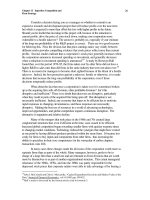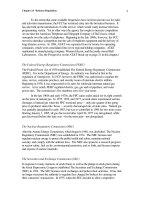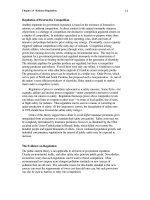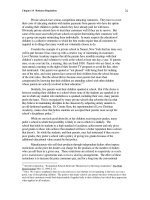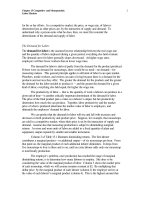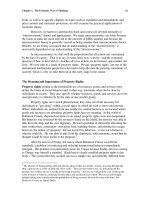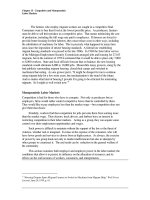MicroEconomics chap001
Bạn đang xem bản rút gọn của tài liệu. Xem và tải ngay bản đầy đủ của tài liệu tại đây (264.49 KB, 23 trang )
Chapter 1: Managers, Profits,
and Markets
McGraw-Hill/Irwin
Copyright © 2011 by the McGraw-Hill Companies, Inc. All rights reserved.
Managerial Economics & Theory
• Managerial economics applies
microeconomic theory to business problems
• How to use economic analysis to make
decisions to achieve firm’s goal of profit
maximization
• Economic theory helps managers understand
real-world business problems
• Uses simplifying assumptions to turn
complexity into relative simplicity
1-2
Microeconomics
• Microeconomics
• Study of behavior of individual economic agents
• Business practices or tactics
• Using marginal analysis, microeconomics provides the
foundation for understanding everyday business
decisions
• Industrial organization
• Specialized branch of microeconomics focusing on
behavior & structure of firms & industries
• Provides foundation for understanding strategic decisions
through application of game theory
1-3
Strategic Decisions
• Strategic decisions seek to shape or alter the
conditions under which a firm competes with
its rivals
• Increase/protect firm’s long-run profit
• While routine business practices are
necessary for the goal of profit-maximization,
strategic decisions are generally optimal
actions managers can take as circumstances
permit
1-4
Economic Forces that Promote
Long-Run Profitability (Figure 1.1)
1-5
Economic Cost of Resources
• Opportunity cost of using any resource is:
• What firm owners must give up to use the
resource
• Market-supplied resources
• Owned by others & hired, rented, or leased
• Owner-supplied resources
• Owned & used by the firm
1-6
Total Economic Cost
• Total Economic Cost
• Sum of opportunity costs of both marketsupplied resources & owner-supplied
resources
• Explicit Costs
• Monetary payments to owners of marketsupplied resources
• Implicit Costs
• Nonmonetary opportunity costs of using
owner-supplied resources
1-7
Types of Implicit Costs
• Opportunity cost of cash provided by owners
• Equity capital
• Opportunity cost of using land or capital
owned by the firm
• Opportunity cost of owner’s time spent
managing or working for the firm
1-8
Economic Cost of Using Resources
(Figure 1.2)
E x p lic it C o s ts
of
M a r k e t -S u p p lie d R e s o u r c e s
T h e m o n e ta ry p a y m e n ts to
re s o u rc e o w n e rs
+
Im p lic it C o s ts
of
O w n e r -S u p p lie d R e s o u r c e s
T h e r e tu r n s fo r g o n e b y n o t ta k in g
th e o w n e r s ’ re s o u r c e s to m a rk e t
=
T o ta l E c o n o m ic C o s t
T h e to ta l o p p o r tu n ity c o s ts o f
b o th k in d s o f re s o u r c e s
1-9
Economic Profit vs.
Accounting Profit
Economic profit = Total revenue – Total economic cost
= Total revenue – Explicit costs – Implicit costs
Accounting profit = Total revenue – Explicit costs
• Accounting profit does not subtract implicit costs
from total revenue
• Firm owners must cover all costs of all resources
used by the firm
• Objective is to maximize profit
1-10
Maximizing the Value of a Firm
• Value of a firm
• Price for which it can be sold
• Equal to net present value of expected future
profit
• Risk premium
• Accounts for risk of not knowing future profits
• The larger the rise, the higher the risk
premium, & the lower the firm’s value
1-11
Maximizing the Value of a Firm
• Maximize firm’s value by maximizing profit in
each time period
• Cost & revenue conditions must be
independent across time periods
• Value of a firm =
T
π1
π2
πT
πT
+
+ ... +
=∑
2
T
t
(1 + r ) (1 + r )
(1 + r )
t =1 (1 + r )
1-12
Some Common Mistakes
Managers Make
• Never increase output simply to reduce
average costs
• Pursuit of market share usually reduces profit
• Focusing on profit margin won’t maximize
total profit
• Maximizing total revenue reduces profit
• Cost-plus pricing formulas don’t produce
profit-maximizing prices
1-13
Separation of Ownership & Control
• Principal-agent problem
• Conflict that arises when goals of
management (agent) do not match goals of
owner (principal)
• Moral Hazard
• When either party to an agreement has
incentive not to abide by all its provisions &
one party cannot cost effectively monitor the
agreement
1-14
Corporate Control Mechanisms
• Require managers to hold stipulated
amount of firm’s equity
• Increase percentage of outsiders serving
on board of directors
• Finance corporate investments with debt
instead of equity
1-15
Price-Takers vs. Price-Setters
• Price-taking firm
• Cannot set price of its product
• Price is determined strictly by market forces of
demand & supply
• Price-setting firm
• Can set price of its product
• Has a degree of market power, which is ability
to raise price without losing all sales
1-16
What is a Market?
• A market is any arrangement through which
buyers & sellers exchange goods & services
• Markets reduce transaction costs
• Costs of making a transaction other than the
price of the good or service
1-17
Market Structures
• Market characteristics that determine the
economic environment in which a firm
operates
• Number & size of firms in market
• Degree of product differentiation
• Likelihood of new firms entering market
1-18
Perfect Competition
• Large number of relatively small firms
• Undifferentiated product
• No barriers to entry
1-19
Monopoly
• Single firm
• Produces product with no close substitutes
• Protected by a barrier to entry
1-20
Monopolistic Competition
• Large number of relatively small firms
• Differentiated products
• No barriers to entry
1-21
Oligopoly
• Few firms produce all or most of market
output
• Profits are interdependent
• Actions by any one firm will affect sales &
profits of the other firms
1-22
Globalization of Markets
• Economic integration of markets located in
nations around the world
• Provides opportunity to sell more goods &
services to foreign buyers
• Presents threat of increased competition from
foreign producers
1-23

